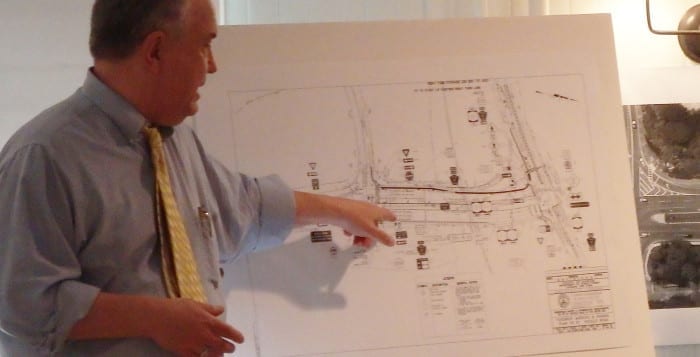By Sabrina Artusa
Residents of Forestwood continue to monitor changes to Blydenburgh County Park, which sits in the heart of their community. At a Forestwood Civic Association meeting, Suffolk County Chief Engineer Alexander Prego fielded questions regarding the design and timeline for a new dam, an essential step in the process of refilling Stump Pond.
The timeline for the lake, a signature characteristic of this national historic site and a major draw for hikers, fishers and kayakers, has been uncertain as county officials navigate permitting and funding.
“Our goal is to build it back better,” Prego said. “That failure that occurred last fall — we need to make sure that we build it for more than that.” The failed dam was classified as Class A, or a low-hazard dam, where failure could result in damage to roads and undeveloped land with an unlikely risk of “substantial economic loss or substantial environmental damage.” The new dam will likely be Class B, or intermediate hazard, reflecting the reality of August’s storm and its potential for “downstream damage,” according to Suffolk County Department of Public Works Commissioner Charlie Bartha. The more “substantial” dam will require more periodic inspections from the New York State Department of Environmental Conservation.
Blydenburgh is on a watershed, meaning the water from over 12,000 acres of land accumulated at the park. “We need to estimate how much water of that 12,000 will be coming in during a 25- or 100-year storm,“ Prego said. The new dam and spillway will be able to handle 225% of a 100-year storm. They installed five stream gauges to record rainfall and tide data. “We need to measure everything coming in here,” he said.
In April, Suffolk County Executive Ed Romaine (R) released a document detailing the steps to be completed, which include permitting and inspections from several different departments such as the DEC and the New York State Historic Preservation Office. Prego said the county aims to have permitting and plans completed by the end of this year.
Of the $6.6 million of county money dedicated to rebuilding, the mapping, engineering planning and other analyses used $500,000.
In addition, they plan to add a fish ladder to promote the migration of the American eel, brook trout and river otters.
Forestwood residents expressed concern for trail accessibility for horses as well as the safety hazard posed by the soft, muddy surface of the empty lake. “What are you going to do to protect the pond area and at the same time protect the kids in our neighborhood?” one resident asked.
The swamp-like crater was described as looking like “a breeding ground for mosquitoes” by one resident, who then asked how it is being treated. The county can use larvicide to eliminate mosquitoes before they hatch, said Suffolk County Council on Environmental Quality Vice Chair Michael Kaufman.
Members of the Suffolk County Department of Parks were invited but were not present for the meeting. Forestwood civic President Robert Sikora called their absence “very disappointing.”
“They should’ve been here,” he said. “This is a park discussion.” Indeed, several residents had questions about trail maintenance that did not fall into the purview of the public works department.









